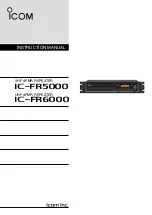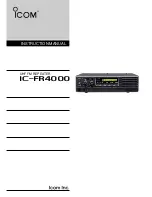
www.johnsonandstarley.co.uk
6
TABLE 2. MINIMUM EFFECTIVE AREAS
VENTILATED FROM INSIDE
BUILDING
Low level grille 270cm
2
(42.0in
2
)
High level grille 270cm
2
(42.0in
2
)
VENTILATED FROM OUTSIDE
BUILDING
Low level grille 135cm
2
(21.0in
2
)
High level grille 135cm
2
(21.0in
2
)
7.
VENTILATION AIR
7.1
When installed in a compartment two permanent ventilation openings into the compartment are required, one
at high level and one at low level. The minimum effective areas specified in Table 1 are related to the rated
heat input of the air heater and assume that an INTEJAN circulator is fitted.
8.
DUCT SYSTEM
(See British Design Manual - Gas fired Warm Air Heating)
8.1
RETURN AIR
8.1.1
Room-sealed appliances may be installed without return air ducting, provided that the path between
the return air grille and the appliance return air inlet is protected in such a manner that the required
air-flow will be maintained at all times. The return air grille MUST have a free area of not less than
1593cm
2
(291in
2
). It is recommended that the return air duct not be routed directly from the main
living area, but from a convenient central area serving the remainder of the dwelling.
8.1.2
The return air system should be constructed of fire-resistant material. The flue shall not be run through
an area serving as a return air plenum. It is extremely important that the correct size of return air
grilles and ducting is used. For heaters on maximum output the return air duct size should not be
less than the equivalent of 300mm x 300mm (12” x 12”). If flexible duct is used the duct diameter
should not be less than 350mm (16”) dia. The return air grille should have a free area of not less
than 1593cm
2
(291in
2
).
8.1.3
An adequate and unobstructed return air path is essential from areas not served by a directly ducted
return and to which warm air is delivered. All such rooms should be fitted with relief grilles which
have a free area of 0.0088m
2
/kW (1in
2
/250Btu/h) of heat supplied to the room. The only exceptions
are kitchens, bathrooms and WCs.
8.1.4
The return air duct should allow for ease of removal for access to the flue.
8.1.5
All duct work in the room or internal space in which the heater is installed shall be mechanically
secured and sealed with ducting tape.
8.2
WARM DELIVERED AIR
8.2.1
All duct work, including riser ducts, should be fully insulated with 50mm (2”) fibreglass or similar.
If short extended duct runs are taken below floor level these should be similarly insulated and in
addition wrapped with a sound vapour proof barrier. They must also be protected from crushing.
8.2.2
The duct system should be carefully designed (as given in the guidelines in the British System
Design Manual) to suit the needs of specific heating requirements and building layout. The type of
duct system (e.g. radial/extended plenum/ stepped) should be installed using the least number of
fittings to minimise airflow resistance. The base duct, which equalises the air pressure to supply
ducts, must be constructed to support the weight of the heater, which must be sealed using self-
adhesive foam strip, ducting tape or sealing compound. All ducting and blanking plates must be
mechanically secured and sealed.







































